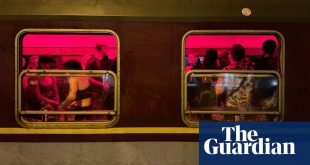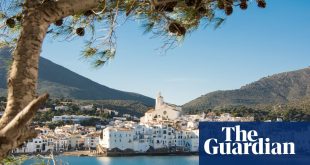part one | part two | part three | part four | part five
Type the names of many ordinary towns into Google followed by “is” and the search engine often autocompletes with “a dump”. The predictive text becomes self-perpetuating as people click on the link, through curiosity or accident. Local newspapers abet negativity with regurgitations of “worst places to live” rankings from surveys commissioned by dubious sources trying to grab attention in the digital media morass. The five towns featured below have surfaced on such lists, but ugliness has as many forms as beauty, as Dylan Thomas hinted at when he called Swansea “an ugly, lovely town”. Both adjectives can be simultaneously true. The ugliest place in England for me is Belgravia, London, where monotonous facades and security cameras sneer down at empty pavements. I think Belgravia “is a dump”. But I’d still go there to see it, understand it, know it.
Dungannon, Co Tyrone
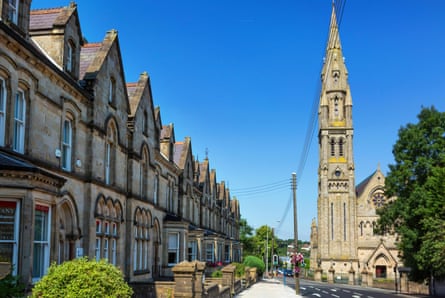
If Hugh O’Neill, earl of Tyrone, had had his way, Dungannon would be the capital of Ulster. It’s odd to imagine a Northern Ireland that didn’t evolve around Belfast and the sea, but looked to this far-seeing hilltop town for spiritual and political guidance. To condense 400 years of history, what happened was: O’Neill doubled up as regional leader and agent for Elizabeth I; then he didn’t; he led a rebellion of earls against the English crown; they lost; the earls and their followers fled to Spain to muster a force, or reflect in exile; they never got there.
All this, and more, is explained in an impressive exhibition at Dungannon’s Ranfurly House, which stands beside the Hill of The O’Neill (Ireland’s great princes got their own definite article). As well as the storytelling, artworks and archaeological information, I was struck by three parallel timelines – one for Ireland, one for England and Scotland, one for the Americas and Rest of the World. As the centre’s genial guide Peter Lant says: “Nothing ever happens only in one place.” Dungannon is an epicentre, a crossroads, a place where the past is layered and deep. The earls had stone seats that symbolised their power. Dungannon is like a mighty throne, hill-shaped, laden with history and memory.
Over the centuries, the hill has been Druidic stronghold, Irish fortress, plantation castle, back garden of 19th-century banker Thomas Knox Hannyngton (two towers of his Georgian house still stand), British Army base and observation tower, and, more recently, improvised TV studio (used during the pandemic) and wedding venue. The huge communications mast isn’t pretty; the two large CCTV cameras are army-issue. But the views of Dungannon’s lofty church steeples and surrounding farmlands are sweeping, and beyond lie the Cooley and Mourne mountains.
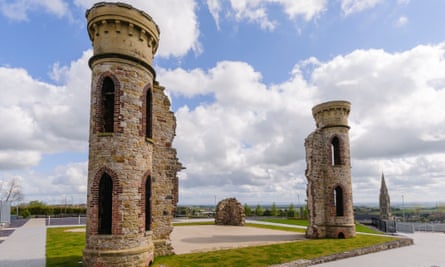
The town square – laid out at the start of the 17th century on English lines by Sir Arthur Chichester, lord deputy of Ireland – is broad and airy, and a market sets up on Thursdays. There’s plenty of functional redbrick – Dungannon was one of the most bombed towns during the Troubles – but old buildings survive: Scottish baronial-style police barracks; the French gothic St Patrick’s church, designed by JJ McCarthy, “the Irish Pugin”; grand townhouses; terraced cottages in Milltown. Dungannon, with Belfast and Newry, was a vertex of the Linen Triangle, turning out huge quantities of brown cloth. There are still jobs and a degree of affluence here; the Deli on the Green is as smart as any Belfast bistro.
A 2014 survey found Dungannon to be one of the five cheeriest towns in the UK. Guardian writer Zoe Williams wrote: “I don’t know how” as it was “easily the ugliest town I’ve ever seen.” Perhaps it rained that day. But locals love it and so do incomers. Pre-Brexit, the area was an east European hotspot. Today, Northern Ireland’s largest community of East Timorese immigrants swell local Catholic congregations, some excelling at Gaelic football.
The Flight of the Earls; the arrival of the hopeful. Unfinished stories. Dungannon has been attacked, but is very much intact – and it has some of the best views, and stories, in Northern Ireland.
Things to do: Lough Neagh; Mid-Ulster Cycle Route; Hill of The O’Neill & Ranfurly House; OM Dark Sky Park, the Sperrin mountains
Burnley

“I’ll tell you now and I’ll tell you firmly, I don’t never want to go to Burnley.” In John Cooper Clarke’s parody of Elvis Costello’s (I Don’t Want to Go to) Chelsea, I trust he is being ironic. He’s a Lancastrian, after all, and this Lancashire town once identified as the powerhouse of Cottonia – as the historian Douglas Farnie dubbed the textile processing and manufacturing region that grew up around Manchester. By the end of the 19th century, Burnley claimed to be the “weaving capital of the world”. At the peak of output just before the first world war, around 100,000 looms (about one for each resident) were clattering in the town producing millions of miles of cloth.
I live 10 miles from Burnley but, with Pendle Hill blocking the way, don’t go as often as I could – and should. On my first trip, the town seemed lost. It was me. I took a wrong turn and found myself amid traffic, failing to find the centre, being blocked from accessing a river gully, and wondering at a large modernist redbrick building that reminded me of crematoriums and, by its art deco straight lines, Liverpool’s old Pools building. Apparently, Prestige Park was built in 1937 as a countermeasure against the decline of the cotton industry, which had shifted to Japan and India in the interwar period. It housed a factory producing pressure cookers and Ewbank carpet sweepers – the futuristic gizmos of another era. The architects, Wallis, Gilbert and Partners, considered jazz age giants, also built the Hoover Factory in Perivale, London, and the Firestone factory in Brentford (demolished in 1980). I had a decent curry and a craft beer at the Bridge Bier Huis, but they weren’t a raison d’être. Burnley seemed to be hiding.
On a second day trip, I found imposing buildings that hinted at the industrious heyday: the town hall, Carnegie library, Mechanics theatre, Newtown Mill. They seemed somewhat stranded, with car parks and wide roads cutting deep into the civic heart. Plaques commemorated 327 men and boys killed working in local coalmines (Garney, James, 12; Eddleston, John Richard, nine … ) and the first meeting of the Campaign for Homosexual Equality in 1971 – Burnley was the birthplace of gay civil rights in the UK. The 60s-style shopping area segued into streets of elegant sandstone buildings; many of the palazzos were by William Waddington, a local architect.
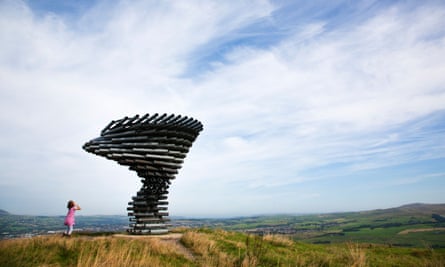
A dark, satanic supermarket greedily overlooks the civic heart. Now it’s food that’s spun, woven, dyed and bleached. A staircase behind took me on to the Leeds-Liverpool canal, which was clogged with weeds but where the embanked towpath along a section called the Straight Mile allowed me to take in a panorama of old wharves, former mill complexes and lots of new-build. The biggest structure is football stadium Turf Moor, which occupies one of the town’s commons, but much of central Burnley is a patchwork of industrial estates. The economy is sustained by aerospace, food processing, door and window design, stairlifts and mobility scooters, recording studio mixing consoles, distribution and logistics, and brewing. Christmas office parties must be wild.
UCLan (University of Central Lancashire), formerly Preston poly, is smartening up several crumbling gritstone buildings. As well as amelioration, there is curated memorialisation, at the cosy Weavers’ Triangle museum, at Oak Mount Mill (with its working steam engine) and, a little way out of town, at Queen Street Mill. But the most evocative piece of heritage is Burnley Wharf, a place of dank silence and cold shadows waiting for the return of the last coal barge that chugged out in 1964, or, as is more probable, for regeneration.
Things to do: Weavers’ Triangle, Towneley Hall (conservation work in progress); Singing Ringing Tree
Merthyr Tydfil

Merthyr lies in its wide valley like a mystery, an unreal city. It is Wales’s archetypal Waste Land, a once mighty industrial capital left to rust and rot. A densely built and peopled place amid green hills south of the solitudes of the Bannau Brycheiniog (Brecon Beacons) national park. On high walks in the latter, you catch sight of the conurbation – the grey of pebbledash by day, the yellow of streetlighting after dark. But few hillwalkers descend this way, pushing on to pretty villages and “traditional pubs” in Hay-on-Wye and Brecon instead.
Merthyr’s magic begins with its name. Tydfil, or Tudful, was the daughter of King Brychan, an early Christian convert whose name lives on in the park’s name. She was slain by Saxon or Welsh pagans, hence “merthyr” or “shrine to a martyr”. Despite the presence of a pony-trading fair from medieval times, Elizabethan-era ironworks near the Pont-y-gwaith bridge and regular farmers’ markets, there was no serious settlement of the area until the 18th century.
But the green hills had everything the modern world needed: timber to build, coal to burn, water to make steam, iron ore to smelt and limestone for the kilns. Four huge quasi-feudal estates employed 14,000 men, working night and day to meet the global demand for iron and steel for industry, railways and guns. The borough’s only Grade I-listed building is the 72-room, fortified Cyfarthfa Castle, built for the Crawshay dynasty of ironmasters. Donny Osmond, who traces his family history to Merthyr Tydfil, played a Donny Comes Home concert in its grounds in June 2007 to thousands of adoring fans under pelting rain.
Workers flooded in, and by the 1820s Merthyr became the most populous town in Wales, far bigger than Swansea or the tiny village of Cardiff. Take an industrial walking tour to see what’s left of the Cyfarthfa ironworks, Gurnos Tramway, Dowlais ironworks engine house (Dowlais was the world’s largest iron production centre), Cefn viaduct and Trevithick railway tunnel; the world’s first steam locomotive-hauled railway journey took place in Merthyr on 21 February 1804. To get a sense of where and how an ordinary ironworker lived, 2 Chapel Row is a house-museum and the birthplace of Joseph Parry, who worked in the puddling furnaces as a child and went on to become a celebrated composer.
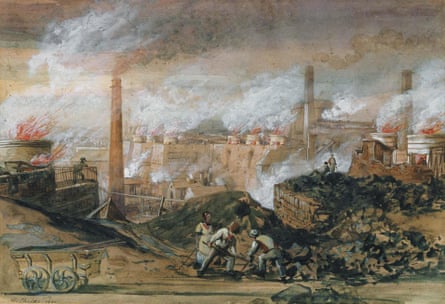
Merthyr exported pig iron all over the world. It also sent out talent. John Hughes, born in 1814, became a magnate in the metallurgical world. He worked in Imperial Russia and built a state-of-the-art plant in Hughesovka on the River Kalmius in Ukraine. It’s now the city of Donetsk.
In May and June 1831, miners rose up, demanding reforms and fair wages. More than 2,000 workers gathered at Waun Common before seizing control of Merthyr. They faced off against the ironmasters, flew the red flag for the first time on British soil, and cried: “I lawr â’r Brenin! (Down with the king!)”. Troops were sent in and after initially being beaten off, defeated the rebellion. Twenty-four men were killed. The local Wetherspoon’s is named Y Dic Penderyn after a miner who was found guilty, on dubious grounds, of stabbing a soldier, and sentenced to be hanged in Cardiff; a plaque on the Arts and Crafts-style Carnegie library across the road honours his memory. Dic has a dedicated walking trail.
Welsh radicalism is said to have its origin in the Merthyr Rising. It marked a decisive phase in the evolution of the trades union movement. Visitors noted the high level of literacy and learning among the working classes. At the 1900 general election, Scotsman and former coal miner Keir Hardie won one of Merthyr’s two parliamentary seats, standing for the LRC – the precursor of the Labour party.
after newsletter promotion
As if Merthyr Tydfil didn’t have enough lines of convergence, two tributaries of the River Taff meet close by and flow through the town’s western edges before leaving for Cardiff just as, ultimately, the money and power and people would, too.
I am not the first to be thrown by Merthyr’s location and topography. US consul to Wales Wirt Sikes wrote in 1881: “Many of the hills, and these not always the lowest, are composed wholly of dross from the iron forges. Some of these huge dumping heaps are almost worthy of the title of mountains, so high and steep are they. By day they are black, but at night they glow red with fire, and are very picturesque to see, in conjunction with the chimneys which belch smoke and flame all round the sky.”
Things to see: Bike Park Wales, Taff Fechan nature reserve, Taff Trail
Harlow, Essex
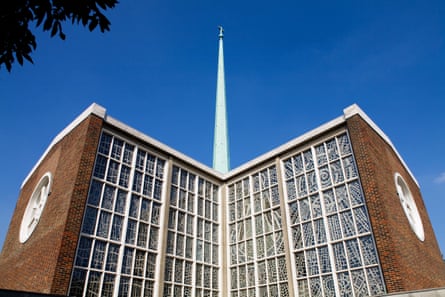
On 25 March 1947, Harlow was designated a new town – the fourth of the first wave of urban developments that grew out of the earlier Garden City idea, intended to alleviate housing shortages after the second world war. While only seven miles from London’s Tube network, Harlow was surrounded by farms and fields. It had an initial population of 4,400. Master planner Frederick Gibberd split the area into four districts, each with housing, shops, schools and green spaces. Britain’s first pedestrian precinct was built in Harlow. So was the first tower block, called The Lawn. These are not small things. JG Ballard wrote that the opening of the M1 was more important than Look Back in Anger. Flagged piazzas and vertical dwellings had more impact on the lives of people in the 20th century than James Joyce or David Bowie.
After 40 years the town was finally finished in 1980, by which time the utopian ideals underpinning the project were being cast into Thatcher’s anti-society pyre. When we walk around Harlow we are witnessing, in every cracked piece of reinforced concrete, the rise and fall of Britain.
Standout spaces and buildings include the shopping centre, Town Park, the Mark Hall North, Morley Grove and Orchard Croft neighbourhoods, the Gibberd Garden and Terminus House. Others – the YWCA Tower, the Gilbey’s Gin complex – have been razed. More than 100 works make up Harlow’s Sculpture Town, including important pieces by Ralph Brown, Elisabeth Frink, Barbara Hepworth, FE McWilliam, Henry Moore and Willi Soukop. The concept came out of the 1951 Festival of Britain, at which each building was accompanied by a large artwork. On trips to Italy, Gibberd had appreciated the way public sculptures reinforced places’ identity. He wanted Harlow to be “the Florence of Essex”. The first sculpture was Hepworth’s Contrapuntal Forms, resited from the festival and now on the Glebelands housing estate. An 1882 bronze statue of Eve by Auguste Rodin is outside Nando’s. A searchable map is available.
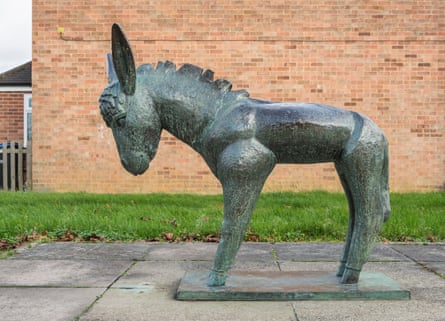
Two temples will convert visitors to the Modernist credo. St Paul’s was the first postwar church to be completed in a new town centre. Built between 1957-9 by ecclesiastical specialists Humphreys and Hurst, it was intended to be a lavish “mother church”. It has a bright interior with dark red ceilings above the aisles and blue ceilings with white beams for the nave and transepts. Glazing is a mix of plain and lemon yellow glass. There’s a hypodermically emphatic copper spire, separate belltower and a mosaic of Christ at Emmaus by John Piper – his first completed work for a church.
The Roman Catholic Church of Our Lady of Fatima in Harlow, built in 1960 and recently upgraded to Grade II* status, was designed by Gerard Goalen. It has a strident T-shaped layout, and uses concrete and Surrey stock bricks, with a needle spire and simple colour scheme. It was Goalen’s first ecclesiastical commission and would set him on the way to becoming a leading architect in Roman Catholic modernism. Goalen was brought in by Gibberd, who went on to win the competition to design Liverpool’s Roman Catholic cathedral: Paddy’s Wigwam, one of the UK’s most recognisable buildings.
Things to see: Harlow Museum & Walled Gardens, Parndon Wood nature reserve.
Barrow-in-Furness

Warmongers, workers and writers mingle awkwardly in the ghost-past of Barrow-in-Furness, the Lancashire town that became an uncouth margin of touristy Cumbria in the local authority shake-up of 1974.
Or should that be Barrow-on-Furness? That was the title used by Portuguese poet Fernando Pessoa for his poem about a much-travelled Portuguese engineer who found himself sat on a drum in the docks, melancholy and unmoored. He concluded: “The metaphysics of sensations – let us put / An end to this and to everything else. Ah, / What human yearning to be river or wharf!” Pessoa liked skewing facts; he adopted the name Álvaro de Campos (1890–1935) to write this and other works. He used 75 pseudonyms during his short career. Pessoa most likely learned about the town after seeing Barrow-built ships in Lisbon. He was responding to the Duddon sonnets, Wordsworth’s poetic celebration of the river that linked Lancashire with the counties of Westmorland and Cumberland – recently reinstated.
In the summer of 1914, newlyweds DH and Frieda Lawrence visited while on a walking tour with three friends. The author, seeing workers pouring into the Vickers armaments factory, realised the “Great War for Civilisation” had begun. In a letter to Lady Cynthia Asquith, he contrasted the “amazing, vivid, visionary beauty” of the Lakes with the “immense pain everywhere”. Barrow was a huge machine-shop, a clanging, pulsating, steaming testament to all the things Lawrence feared and despised.
It was the establishment of the Hematite Iron and Steel Works in 1859 that first fired Barrow up; it would eventually boast the largest steelworks in the world. In the 1880s salt was discovered on Walney Island; the Barrow Salt Works became a major concern. Shipbuilding took off around the same time. The Royal Navy’s first submarine, HMS Holland 1 (AKA Torpedo Boat No 1) was launched in 1901. The Vickerstown Estate was built to house employees. Dominion Street, Powerful Street and Vengeance Street honour Barrow-built warships. Steel, salt, sea-water. Violence and Erosion.
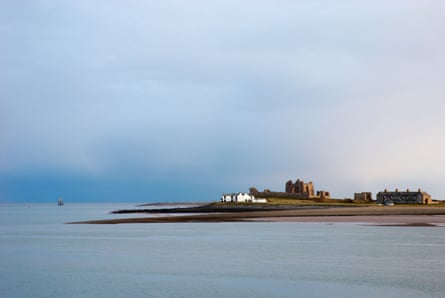
Barrow was dubbed “the Chicago of the North”. It gets the chill winds but is free of skyscrapers. Instead there are stately Victorian and Edwardian buildings on tree-lined avenues, including a Beaux-Arts public library, Custom House, Town Hall, redbrick and terracotta fire station and Gothic revival Duke of Edinburgh Hotel, built in the Belle Epoque 1870s, where it’s claimed Cary Grant and Charlie Chaplin were accommodated – though the latter was probably a clog-dancing child when he visited. Less pretentiously, an 1866 trades directory calls Barrow a “combination in appearance of Birkenhead and a gold finders’ city on the edge of one of the western prairies of America”. Glasgow-style tenements suggest a more solid commitment to work.
Today, the town has far above the national average of manufacturing jobs. BAE Systems maintains the link with war and water through its Vanguard-class subs. A new wave of peaceful engineering has also found an anchor in the town. Five windfarms guard the coast, including the 56-square-mile Walney extension, for a time the biggest in the world.
The wonder of the west-facing view out toward the Irish Sea is different in nature to that offered by the fells behind, but it offers a comparable sense of mental liberation. Stand on Earnse Bay, a sand and shingle beach on the western edge of Walney Island and you can see the Isle of Man, once part of the ancient Hebridean kingdom of Suðreyjar – which was anglicised as Sodor and reimagined, by the Rev Wilbert Awdry, as a huge island so that Thomas the Tank Engine and friends had enough track on which to tell their stories.
Things to see: Furness Abbey, Swarthmoor Hall, Cistercian Way, boat trips to Piel Island for views, birds and a grey seal colony
 Top Naija News: Nigerian News, Breaking News Nigeria and World News Top Naija News is a daily news publication in Nigeria, delivering the latest breaking news in Nigeria and around the world.
Top Naija News: Nigerian News, Breaking News Nigeria and World News Top Naija News is a daily news publication in Nigeria, delivering the latest breaking news in Nigeria and around the world.

